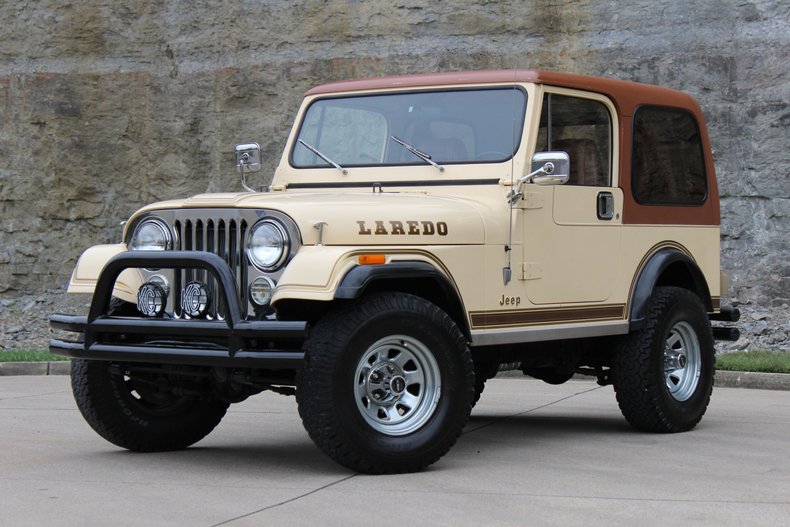Laredo is primarily known as one of the grades among various Jeep models, but did you know that that wasn’t always the case? Back in the day, this marque was also used for a separate model, which was produced back in the 1980s.
We are talking about the Jeep Laredo, a well-known name among older generations of Jeep enthusiasts in Australia.
That model was heavily based on the legendary CJ SUV, the company's most iconic nameplate, produced for several decades. The Jeep Laredo was a luxurious and refined model, designed for both on- and off-road purposes, which wasn't the case with the previous iteration of the legendary CJ SUV.
Jeep Laredo in Australia (1982-1984)
The original CJ was primarily designed for military purposes and heavy off-roading in general. However, the Jeep management realized its potential for civil use, so the goal was to create a model appropriate for a broader range of buyers. That was finally achieved in the late 1970s when the CJ-7 was introduced.
The CJ-7 was a direct successor of the CJ-5, which was in production for over two decades. The new model brought several improvements, including a more capable powertrain, more refined transmission, and a new 4x4 system. It was also notably bigger, which provided more space on the inside.
So, the goal was to offer a more luxurious iteration, which would not only be a great off-roader but also a good people hauler. For that reason, the company introduced the Jeep Laredo in 1980.
This model was in production between 1980 and 1986, while the Australian version was available for about three years, from 1982 to 1984.
Design
As mentioned, the Jeep Laredo was heavily based on the CJ-7. Its overall design was the same as the new platform that included a significantly upgraded chassis. It had a couple of C-shaped rails, new springs, and shock absorbers that were moved farther to the outside. Such a layout provided better handling and a smoother ride.
Speaking of the suspension setup, the new Jeep Laredo was equipped with hydraulic dampers and semi-elliptic leaf springs on both axles, which were solid, of course. Disc brakes were installed at the front, while the rear end was equipped with typical drum brakes.
The Jeep Laredo price was notably higher than standard CJ-7 models, and it is easy to see why. This version was characterized by unique trims, such as the chrome details on the bumpers, grille, and side mirrors.
Another reason why this version was more expensive is its more luxurious interior. It wasn't common to see an off-roader with bucket leather seats or a tilt steering wheel back in the day.
Dimensions
The Jeep Laredo was based on the CJ-7, and as we already mentioned, it was notably bigger than the previous-generation CJ-5 model. This redesign brought an almost 250mm longer wheelbase, while the other dimensions were much bigger. That change provided much more space on the inside and a much higher level of comfort.
So, the Jeep Laredo featured 2,370mm in the wheelbase, with an overall length of 3,890mm. The SUV was 1,520mm wide and 1,790mm high, while the kerb weight was around 1,300kg. The ground clearance was at a respectable 210mm, guaranteed high off-road potential.
Jeep Laredo Dimensions
- Wheelbase: 2370mm
- Height: 1790mm
- Length: 3890mm
- Width: 1520mm
- Ground clearance unladen: 210mm
- Kerb weight: 1300kg
- Turning circle: 11.58m
- Rear track: 1400mm
- Front track: 1471mm
Engine
One of the biggest problems with the previous CJ-5 model was its powertrain, which was outdated and quite underpowered. So, the new CJ-7 came with many new engine options, including the good-old C240 diesel from Isuzu. However, the Laredo was designed as a luxury SUV, available in just one capable petrol engine.
That engine was a 4.2-litre AMC inline-six, with a max output of 72kW and 261Nm of max torque. The engine was paired with a 4-speed manual transmission, while models with automatic gearbox were offered in other markets.
Besides the new engine, Jeep Laredo also came with a new automatic 4x4 system, codenamed Quadra-Trac, which Jeep will work on in the following decades to create one of the best four-drive systems in the world. The Jeep Laredo towing capacity was rated at around 900kg.
Jeep Laredo Engine Specs
- Engine Capacity: 4228cc
- Number of cylinders: 6, inline
- Fuel type: Leaded Petrol
- Forced Induction: -
- Maximum power: 72kW
- Maximum torque: 261Nm
- Transmission: 4-speed manual
- Drivetrain: 4x4
- Max towing capacity: 900kg
- Fuel tank capacity: 76L
What's the difference between Jeep Grand Cherokee and Jeep Laredo?
The difference is significant in so many ways. First of all, we are talking about models from different eras, as the original Grand Cherokee wasn't introduced before the early 1990s.
Also, the overall design is entirely different. The Laredo is primarily an off-road vehicle with a classic ladder chassis. At the same time, the Grand Cherokee features a modern unibody chassis, and it is essentially a crossover, despite pretty good off-road performances.
Furthermore, Jeep Laredo is not in production anymore. The successor came as a Jeep Wrangler, while the Grand Cherokee succeeded the original Wagoneer.
Today, the Grand Cherokee is a significantly larger vehicle. It even comes with a three-row version that accommodates up to 7 passengers.
Finally, you shouldn’t be confused with the Jeep Grand Cherokee Laredo. While the old Laredo was a separate model based on the CJ-7, the modern-day Laredo is no more than a grade in Grand Cherokee's range and in the range of many other Jeep models.
Besides, the Laredo name is primarily used in North America, while the Australian-market model uses different grade names, such as Night Eagle, Limited, Summit Reserve, etc.
Need replacement parts for your old Laredo? We can help you find what you’re looking for. Want to advertise your Jeep Laredo for sale? Do it on our website and get more interested buyers.
By Nebojsa Grmusa

